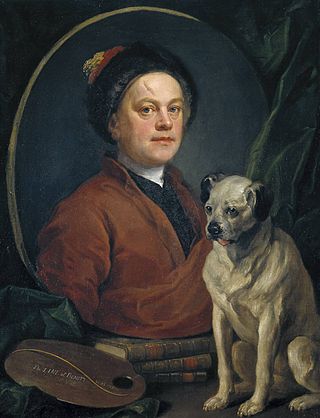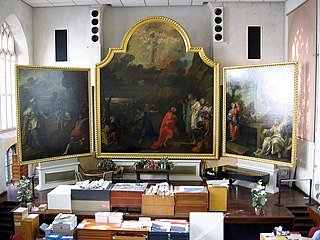
Don Quixote is a Spanish novel by Miguel de Cervantes. It was originally published in two parts, in 1605 and 1615. Considered a founding work of Western literature, it is often labelled as the first modern novel and the greatest work ever written. Don Quixote is also one of the most-translated books in the world and one of the best-selling novels of all time.

William Hogarth was an English painter, engraver, pictorial satirist, social critic, editorial cartoonist and occasional writer on art. His work ranges from realistic portraiture to comic strip-like series of pictures called "modern moral subjects", and he is perhaps best known for his series A Harlot's Progress, A Rake's Progress and Marriage A-la-Mode. Knowledge of his work is so pervasive that satirical political illustrations in this style are often referred to as "Hogarthian".
A Harlot's Progress is a series of six paintings and engravings (1732) by the English artist William Hogarth. The series shows the story of a young woman, M. Hackabout, who arrives in London from the country and becomes a prostitute. The series was developed from the third image. After painting a prostitute in her boudoir in a garret on Drury Lane, Hogarth struck upon the idea of creating scenes from her earlier and later life. The title and allegory are reminiscent of John Bunyan's Pilgrim's Progress.

The Four Stages of Cruelty is a series of four printed engravings published by English artist William Hogarth in 1751. Each print depicts a different stage in the life of the fictional Tom Nero.

Four Times of the Day is a series of four oil paintings by English artist William Hogarth. They were completed in 1736 and in 1738 were reproduced and published as a series of four engravings. They are humorous depictions of life in the streets of London, the vagaries of fashion, and the interactions between the rich and poor. Unlike many of Hogarth's other series, such as A Harlot's Progress, A Rake's Progress, Industry and Idleness, and The Four Stages of Cruelty, it does not depict the story of an individual, but instead focuses on the society of the city in a humorous manner. Hogarth does not offer a judgment on whether the rich or poor are more deserving of the viewer's sympathies. In each scene, while the upper and middle classes tend to provide the focus, there are fewer moral comparisons than seen in some of his other works. Their dimensions are about 74 cm (29 in) by 61 cm (24 in) each.

The Engraving Copyright Act 1734 or Engravers' Copyright Act was an Act of the Parliament of Great Britain first read on 4 March 1734/35 and eventually passed on 25 June 1735 to give protections to producers of engravings. It is also called Hogarth's Act after William Hogarth, who prompted the law together with some fellow engravers. Historian Mark Rose notes, "The Act protected only those engravings that involved original designs and thus, implicitly, made a distinction between artists and mere craftsmen. Soon, however, Parliament was persuaded to extend protection to all engravings."

The Gate of Calais or O, the Roast Beef of Old England is a 1748 painting by William Hogarth, reproduced as a print from an engraving the next year. Hogarth produced the painting directly after his return from France, where he had been arrested as a spy while sketching in Calais. The scene depicts a side of beef being transported from the harbour to an English tavern in the port, while a group of undernourished, ragged French soldiers and a fat friar look on hungrily. Hogarth painted himself in the left corner with a "soldier's hand upon my shoulder."

Charles-Antoine Coypel was a French painter, art critic, and playwright. He became court painter to the French king and director of the Académie Royale. He inherited the title of Garde des tableaux et dessins du roi, a function which combined the role of director and curator of the king's art collection. He was mainly active in Paris.

Beer Street and Gin Lane are two prints issued in 1751 by English artist William Hogarth in support of what would become the Gin Act. Designed to be viewed alongside each other, they depict the evils of the consumption of gin as a contrast to the merits of drinking beer. At almost the same time and on the same subject, Hogarth's friend Henry Fielding published An Inquiry into the Late Increase in Robbers. Issued together with The Four Stages of Cruelty, the prints continued a movement started in Industry and Idleness, away from depicting the laughable foibles of fashionable society and towards a more cutting satire on the problems of poverty and crime.

Columbus Breaking the Egg is a 1752 engraving by English artist William Hogarth. Issued as the subscription ticket for his treatise on art, The Analysis of Beauty, it depicts an apocryphal tale concerning Christopher Columbus's response to detractors of his discovery of the New World. Hogarth uses the story as a parallel to what he considered his own discoveries in art.

Hogarth Painting the Comic Muse is a painting in the National Portrait Gallery, London by the British artist William Hogarth. It was painted in approximately 1757 and published as a print in etching and engraving in 1758, with its final and sixth state in 1764. Hogarth used this particular self-portrait as the frontispiece of his collected engravings, published in 1764.

Elizabeth Needham, also known as Mother Needham, was an English procuress and brothel-keeper of 18th-century London, who has been identified as the bawd greeting Moll Hackabout in the first plate of William Hogarth's series of satirical etchings, A Harlot's Progress. Although Needham was notorious in London at the time, little is recorded of her life, and no genuine portraits of her survive. Her house was the most exclusive in London and her customers came from the highest strata of fashionable society, but she eventually ran afoul of the moral reformers of the day and died as a result of the severe treatment she received after being sentenced to stand in the pillory.

Philippe Mercier was an artist of French Huguenot descent from the German realm of Brandenburg-Prussia, usually defined to French school. Active in England for most of his working life, Mercier is considered one of the first practitioners of the Rococo style, and is credited with influencing a new generation of 18th-century English artists.

Credulity, Superstition and Fanaticism is a satirical print by the English artist William Hogarth. It ridicules secular and religious credulity, and lampoons the exaggerated religious "enthusiasm" of the Methodist movement. The print was originally engraved in 1761, with the title Enthusiasm Delineated, but never published. The original print may have been a response to three essays published by Joshua Reynolds in The Idler in 1759, praising the sublime work of Italian Counter-Reformation artists. It certainly satirized both the English connoisseurs' enthusiasm for old masters and Roger de Piles's Balance de peintres, which was much discussed among art critics in the eighteenth century. However, Hogarth reworked the engraving before publishing it on 15 March 1762 as Credulity, Superstition and Fanaticism: A Medley, now laying more stress on Methodist fanaticism and echoing his earlier print, The Sleeping Congregation of 1736, in which an Anglican clergyman's boring sermon puts his congregation to sleep.

The Female Quixote; or, The Adventures of Arabella is a novel by Scottish writer Charlotte Lennox imitating and parodying the ideas of Miguel de Cervantes' Don Quixote. Published in 1752, two years after she wrote her first novel, The Life of Harriot Stuart, it was her best-known and most-celebrated work. It was approved by both Henry Fielding and Samuel Richardson, applauded by Samuel Johnson, and used as a model by Jane Austen for Northanger Abbey. It has been called a burlesque, "satirical harlequinade", and a depiction of the real power of females. While some dismissed its protagonist Arabella as a coquette who simply used romance as a tool, Scott Paul Gordon said that she "exercises immense power without any consciousness of doing so". Norma Clarke has ranked it with Clarissa, Tom Jones and Roderick Random as one of the "defining texts in the development of the novel in the eighteenth century".
Claude Du Bosc was a French engraver, publisher, and printseller who spent much of his career in London. Associated with French contemporaries such as the painter Antoine Watteau and the draftsman Hubert-François Gravelot, Du Bosc belonged to the first wave of skilled engravers to arrive in London during the early 18th century, playing a major part in improving the standard of English printmaking of that era.
Mark Louis Hallett is a Welsh art historian specialising in the history of Welsh art. He is the Märit Rausing Director of the Courtauld Institute of Art.

Sealing the Tomb is a great altarpiece triptych by William Hogarth in the English city of Bristol. It was commissioned for St Mary Redcliffe in 1755. In the 19th century attempts were made to sell it, but it was given to the Bristol Fine Art Academy, which became the Royal West of England Academy. Its size made it difficult to display and it was rolled up and stored in the basement. In 1973 it was displayed in the ecclesiastical museum created in the war-damaged Church of St Nicholas. When the museum closed it was converted to offices; however the triptych remains in the building. It is on display to the public again after the church was re-consecrated in 2018.
Andrew Carnduff Ritchie (1907–1978) was a Scottish-born American art historian specialising in British 18th-century sculpture, a professor, museum director and post-World War II 'Monuments Man'. He was the director of the Albright-Knox Art Gallery in Buffalo, N.Y., director of Painting and Sculpture at the Museum of Modern Art, and director of the Yale University Art Gallery.















